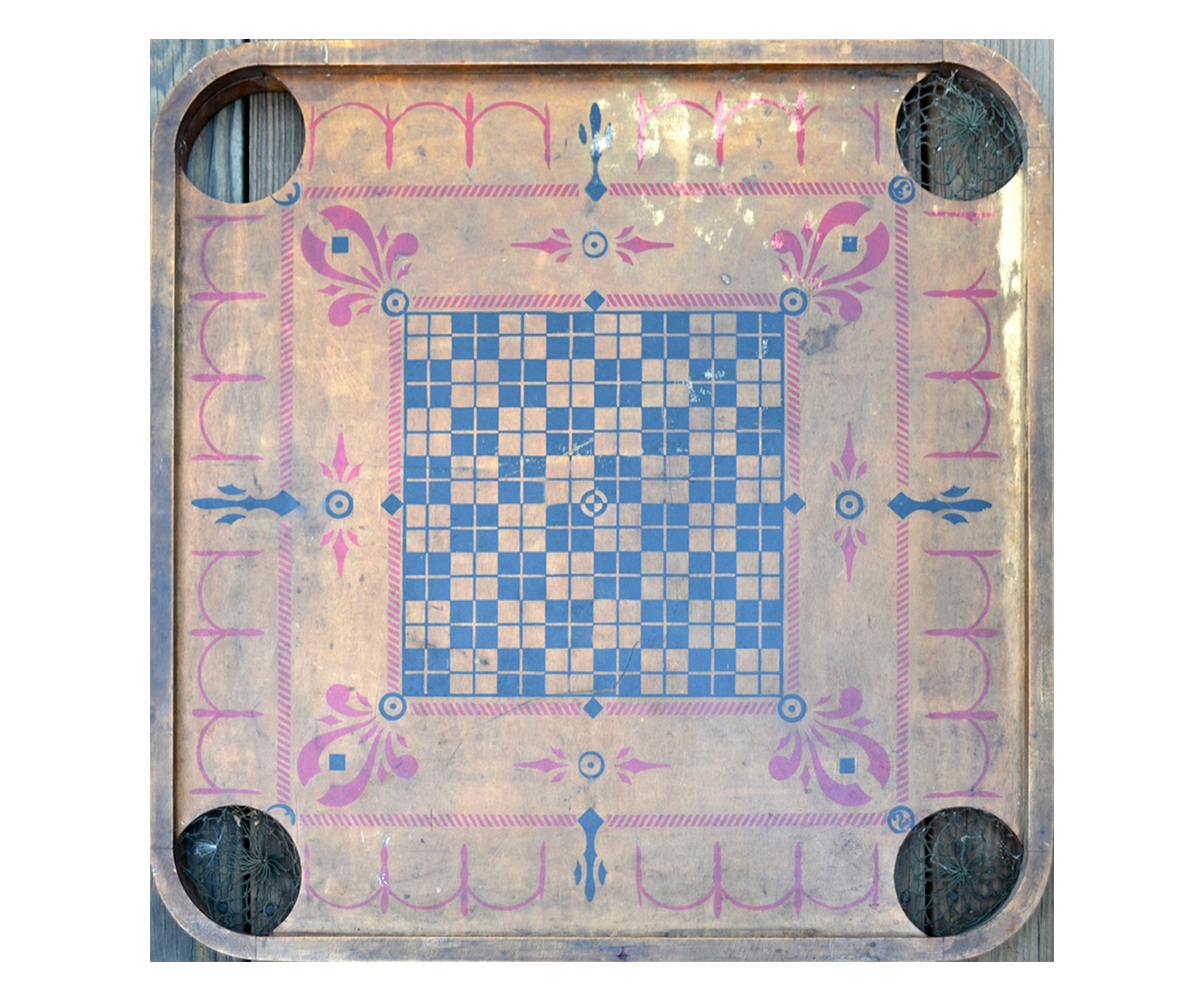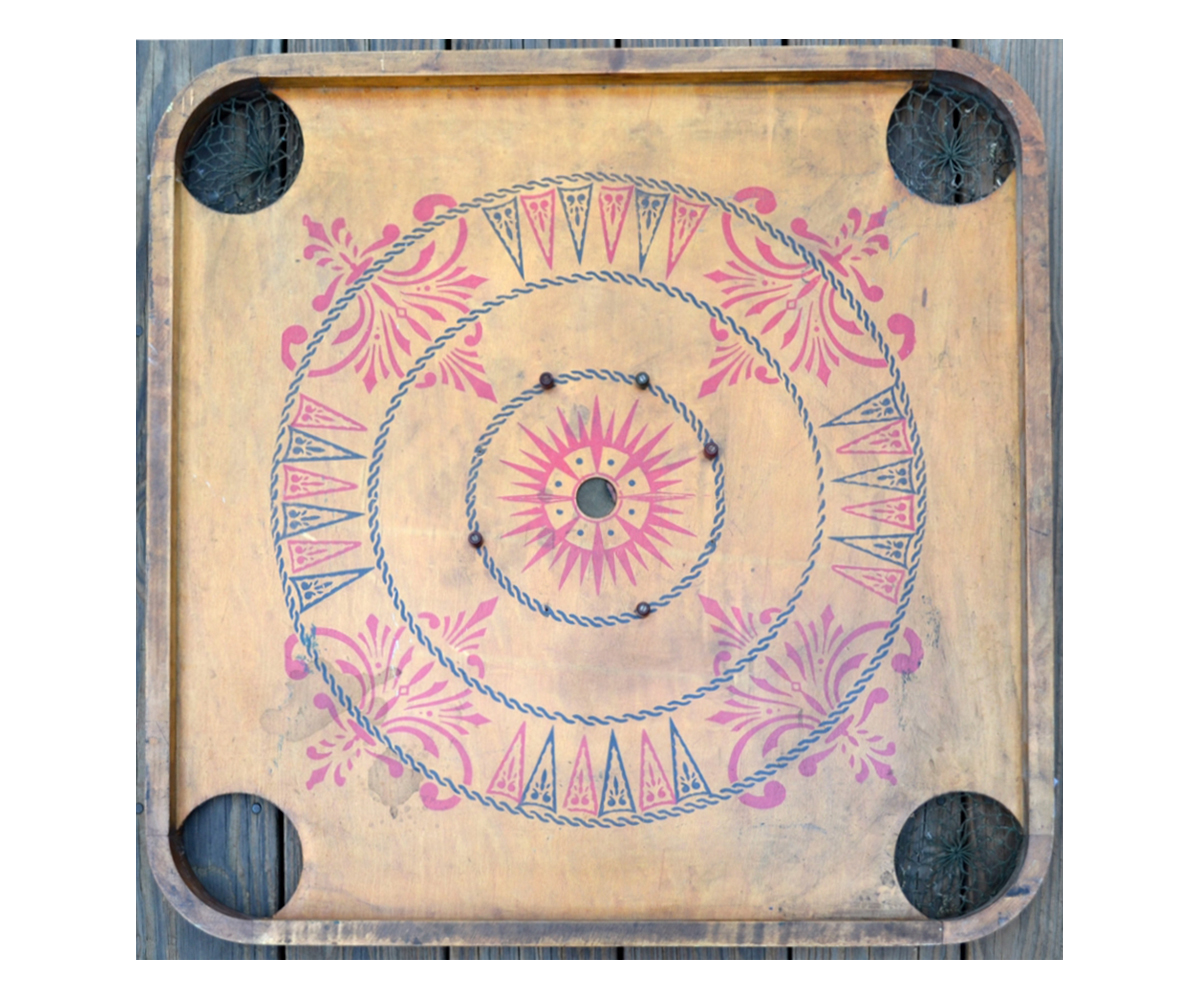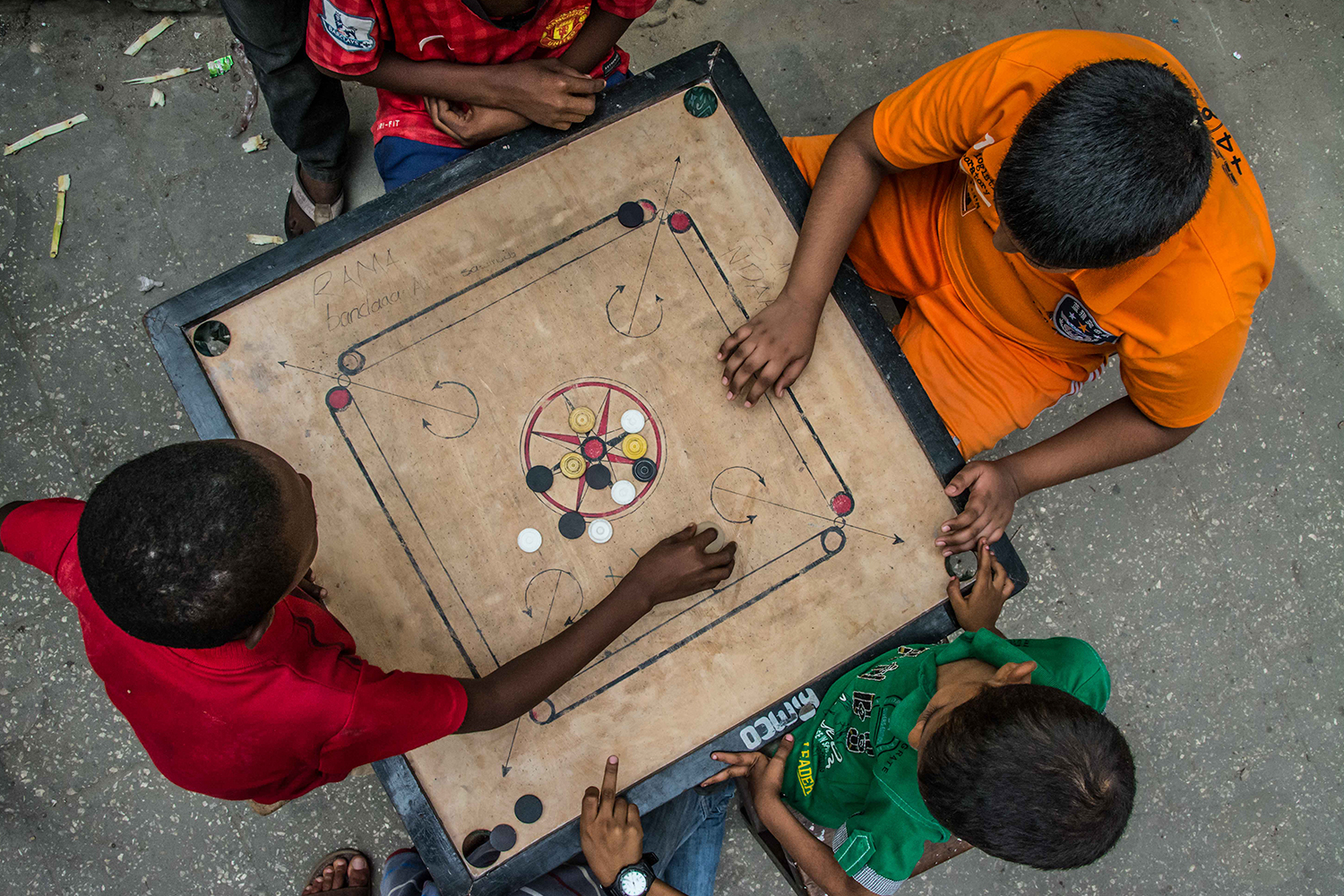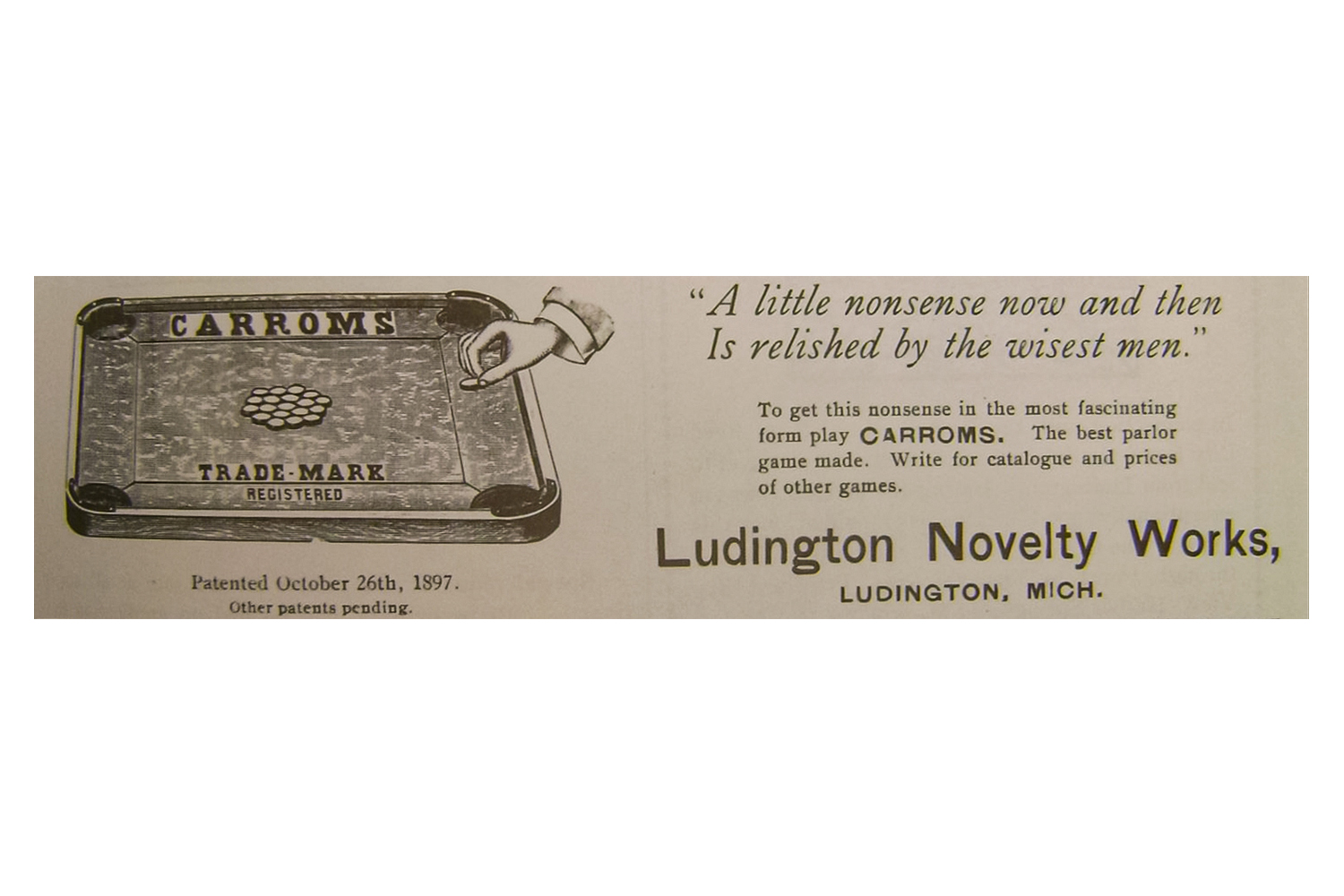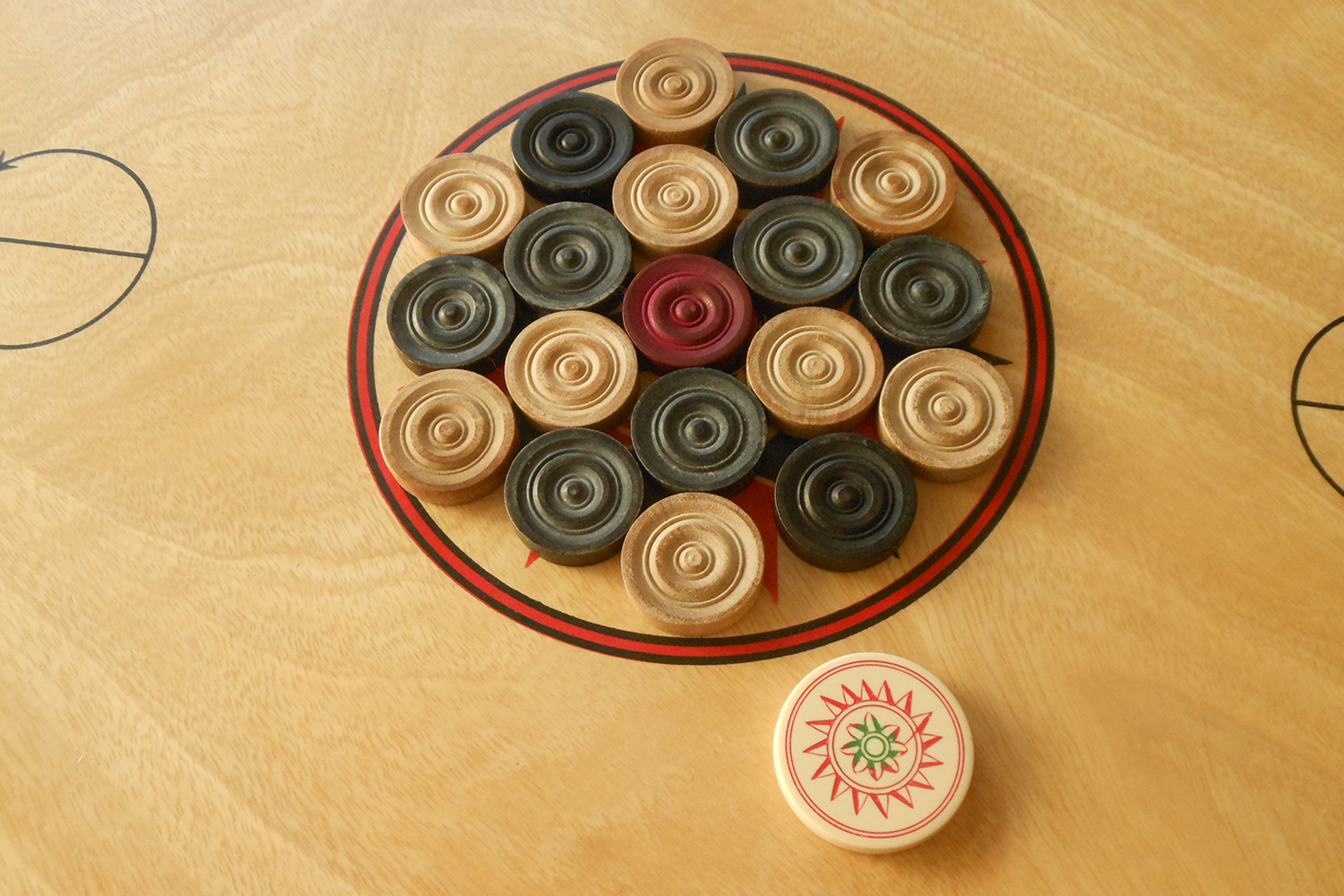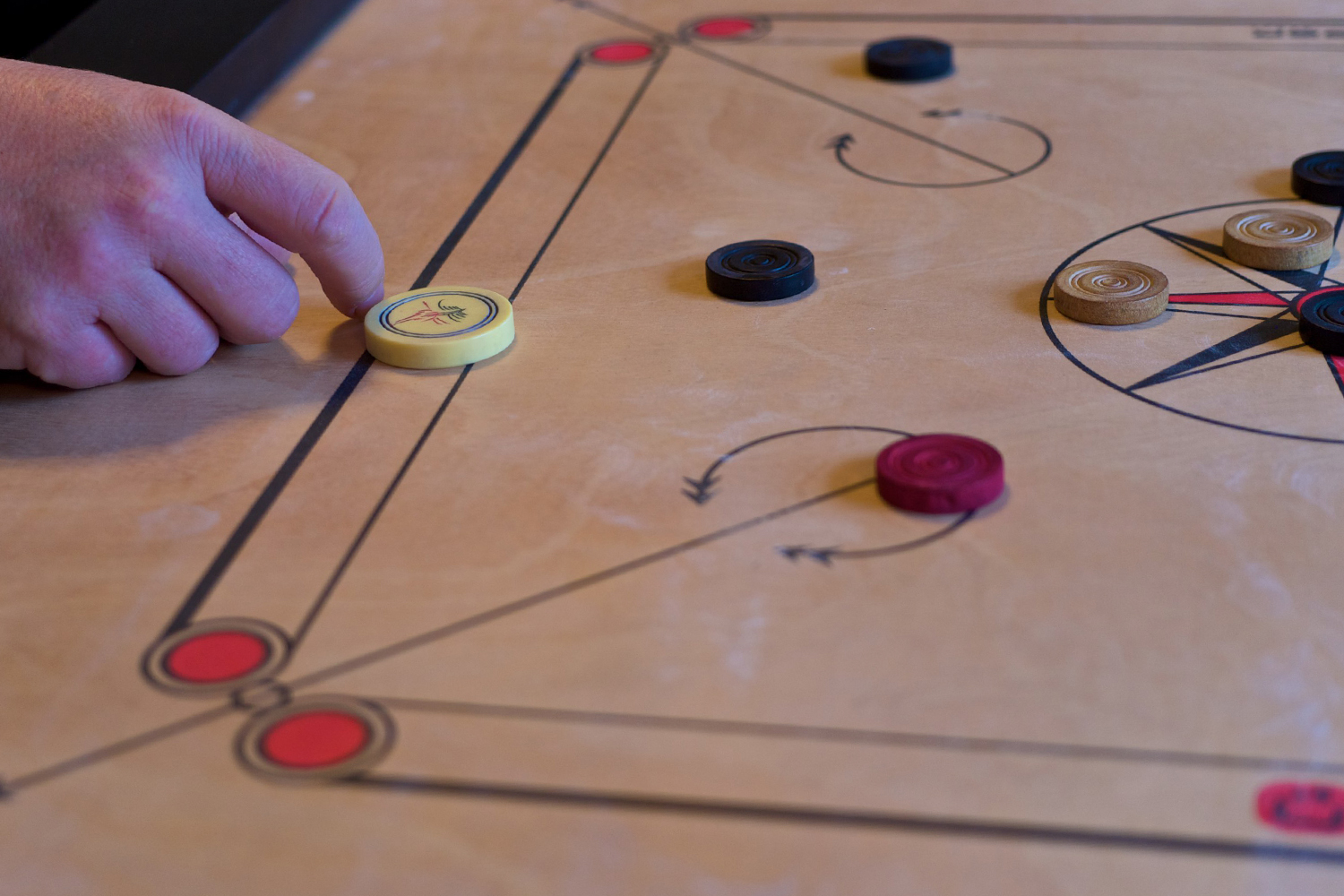ARTICLE
Carrom
A tabletop game for two to four players, carrom is thought to have been invented as an indoor sport in India around the eighteenth century. While there is little information on the game’s precise origins or its early historical development, it remains a very popular household and neighbourhood game in South and Southeast Asia, played by people of all ages. It is a game of skill, involving a high level of hand-eye coordination, dexterity, strategy and spatial visualisation. Having reached the West in the twentieth century, it is also played professionally at an international level.
Carrom is played using coin-like discs on a square wooden board that has a pocket at each corner. The objective is to pocket coins by hitting them with a striker disc that is flicked along the board using the fingers. There are nine black coins and nine white (or unpainted) ones, together called the carrom men, and a singular red coin called the queen. These are about 3 centimetres in diameter and 7–9 millimetres thick. A larger and usually heavier coin, measuring about 4 centimetres and made of smoother material, is used as the striker. While the carrom men and queen are traditionally made of wood, the striker may be made from material such as bone or ivory.
A typical carrom board is a 70–74-centimetre plywood square with raised edges (also called bumpers) that not only keep the coins from sliding off the board, but are also used to create rebounds as the coins are struck. It features 4-centimetre circular cutouts at each corner, beneath which mesh or crochet fabric is attached to catch the pocketed coins. Manufacturers in northern India often use plywood faced with mango (Mangifera indica), or White meranti or makai (Shorea assamica), sourced from eastern India, for the playing surface owing to its relative smoothness. After the surface is smoothened and sealed to make it waterproof, it is provided with markings. Traditionally, the board was painted by hand, but since the late 1980s sports goods manufacturers and artisans have used the more efficient screen-printing technique to mark the carrom board. The board is mounted onto a grid frame of eucalyptus or teak wood to keep it flat and stable. The raised outer frame is made by assembling four wide strips of babool wood (Vachelia nilotica); coated with a paste of chalk powder and wood adhesive, to remove any irregularities and make it smooth; and finally painted.
The game begins with the black and white coins arranged in the medallion at the centre of the board, in an alternating pattern around the queen. One of the players takes the first shot to break this arrangement and commence gameplay. Players alternate turns unless one of them pockets a coin, in which case they continue with their turn until they fail to pocket any coins with a strike. Although various ‘grips’ are used to launch the striker, the rule is that it must be flicked rather than pushed; conventionally players lock the index finger behind the thumb, build pressure, and flick the striker with the nail of the index finger.
There are two broad variations of carrom: the official game as defined by the International Carrom Federation (ICF), and a point-based one that is played more casually. The official version is a two-player game, with a doubles version with four players. Each player or team chooses either white or black carrom men, and aims to pocket all of their respective coins while leaving as many of their opponent’s coins on the board as possible. White takes the first shot. Additional points are conferred for pocketing the queen. In the points-based variation of the game, a player can pocket both black and white carrom men. In this version too, the queen is especially valuable, followed by the white and, lastly, the black carrom men. Such a game ends when one of the players has reached a target score, or once all the coins have been pocketed, with the winner determined by their total points. This version is common among children and beginners, and also allows the game to be played by three players.
A number of additional rules and regulations control the gameplay, including special rules for pocketing the queen. While it is only possible to secure the queen after pocketing at least one other coin, it is only considered pocketed if the player pockets another of their own coins immediately after — otherwise the queen is returned to the board. According to another rule, pocketing the striker itself incurs a penalty for the shooting player. A variation of carrom popular in Pakistan, where it is sometimes called dubbo, is played on a larger board measuring 1 metre or more. It also uses a larger striker, with more lenient rules for flicking or pushing it.
Carrom gained popularity in the West, particularly the UK and USA, after the First World War. The ICF was founded in Madras (now Chennai), India, in 1988, with the aim of regularising the game’s rules and organising tournaments. At the time of writing, it is headquartered in Zurich, Switzerland. Other organisations with similar functions include the Asian Carrom Confederation, the European Carrom Confederation and the US Carrom Association. These in turn regulate activities of national-level carrom organisations, such as the All India Carrom Federation. India exports carrom boards widely, with the USA, the UK, Saudi Arabia and the UAE being the biggest importers during 2022–24.
The Indian government officially recognises carrom as a sport, and offers grants and support to organise state- and national-level competitions. Since 1991, professional carrom players in India are also eligible to be considered within the sports quota for recruitment in public sector organisations. Notable Indian carrom players include Anthony Maria Irudayam, who is a recipient of the 1997 Arjuna Award for sportsmanship, and the only athlete to win it for carrom; S Ilavazhagi, who has won three Carrom World Championships since 2008; and K Srinivas, who won the 2014 championship for India in singles and doubles.
Bibliography
All India Carrom Federation. “Brief on the Game.” Accessed November 30, 2023. http://www.indiancarrom.co.in/brief-on-the-game/.
Carrom Pool. “Analyzing the World of Carrom Board: Parts, Objective and Variations Explained.” October 30, 2023. Accessed November 30, 2023. https://thecarromapk.com/carrom-board/.
Khan, Sara, and Amelia Kosciulek. “How Artisans Make One of Pakistan’s Favorite Board Games.” Insider Docs: Video. Business Insider, December 22, 2022. https://www.insider.com/how-artisans-make-carrom-boards-pakistans-favorite-tabletop-game-2022-12.
“Ilavazhagi is World Champion.” The Hindu, February 19, 2008. https://www.thehindu.com/todays-paper/tp-sports/Ilavazhagi-is-World-champion/article15169357.ece.
International Carrom Federation. “Who We Are.” Accessed November 30, 2023. http://internationalcarrom.com/who-we-are/.
“India Rules at World Carrom Tourney.” The Times of India, September 17, 2014. https://timesofindia.indiatimes.com/city/visakhapatnam/India-rules-at-world-carrom-tourney/articleshow/42673506.cms.
Kumar, Ashok. International Encyclopaedia of Sports and Games. New Delhi: Mittal Publications, 2000. https://www.google.co.in/books/edition/International_encyclopaedia_of_sports_an/Xw-Pi6jTATkC?hl=en&gbpv=0.
Masters Traditional Games. “The Rules of Carrom or Karom.” Accessed November 30, 2023. https://www.mastersofgames.com/rules/carrom-rules.htm.
Mohr, Merilyn Simonds. The New Games Treasury: More Than 500 Indoor and Outdoor Favorites with Strategies, Rules and Traditions. Boston: Houghton Mifflin Company, 1997. https://archive.org/details/newgamestreasury0000mohr/page/68/mode/2up.
Purushothaman, Kirubhakar. “Fostering Champions.” Deccan Chronicle, September 05, 2017. https://www.deccanchronicle.com/sports/in-other-news/060917/fostering-champions.html.
Stevens, Billy. “The Origins of Carrom.” Carrom.org. Last modified December 13, 2001. Archived. https://web.archive.org/web/20150218013220/http://www.carrom.org/game/?subcat=10.
Stevens, Billy. “How to Play.” Carrom.org. Accessed November 30, 2023. Archived. https://web.archive.org/web/20150205075650/http://www.carrom.org/game/?subcat=11.




